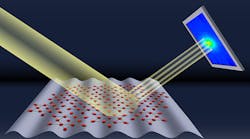Terahertz Spectroscopy Tracks H2O Vapor Temperatures
This file type includes high-resolution graphics and schematics when applicable.
Terahertz signals and radiation (typically considered from 0.1 to 10.0 THz) may seem beyond the range of practical applications, but such high-frequency energy has many uses for otherwise difficult measurements. For instance, when using the relatively “low” terahertz frequencies from 0.5 to 0.8 THz, terahertz spectroscopy systems can measure water (H2O) vapor temperatures in power plants. Measurements of H2O vapor temperatures in coal-fired power plants and other energy-generating facilities are important for process control and efficient operation, as well as for detecting leaks in cooling water systems.
Researchers at the University of Toronto (Ontario, Canada) teamed with engineers at Betterfrost Technologies (also in Toronto) and Arrow Grand Technologies (Covina, Calif.) to demonstrate high-temperature measurements of the H2O vapor volume mixing ratio (VMR) at three absorption peaks for comparison with computer simulations. They noted that traditional methods for measuring other gases, such as carbon monoxide (CO) and oxygen (O2), fail to measure H2O vapor because it condenses after being cooled down during sample preparation, complicating the measurements. However, the use of terahertz energy and terahertz spectroscopy makes it possible to perform direct measurements of H2O vapor temperatures without sample preparation, and to differentiate those measurements from ambient room-temperature water vapor.
The spectrometer test system includes a tunable continuous-wave (CW) terahertz source and analyzer, gas cell, heating system, and purging system. The spectrometer’s tunable frequency ranges from 0.1 to 1.8 THz with frequency resolution of 100 MHz. Data are collected at a scanning step of 1 GHz. Emitted terahertz waves propagate through the gas cell and are detected by a terahertz receiver. The gas cell is enclosed in an air-tight chamber to eliminate ambient water vapor. See “High-Temperature H2O Vapor Measurement Using Terahertz Spectroscopy for Industrial Furnace Applications,” IEEE Transactions on Terahertz Science and Technology, Vol. 6, No. 1, January 2016, p. 26.
Looking for parts? Go to SourceESB.

